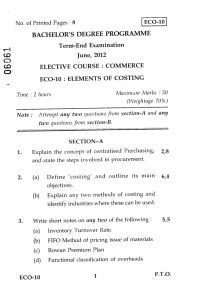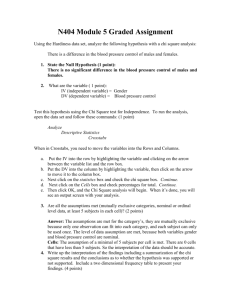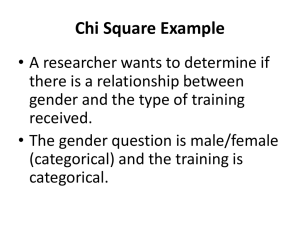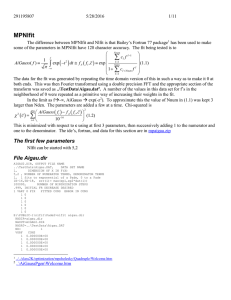Abstract AiGauss
advertisement
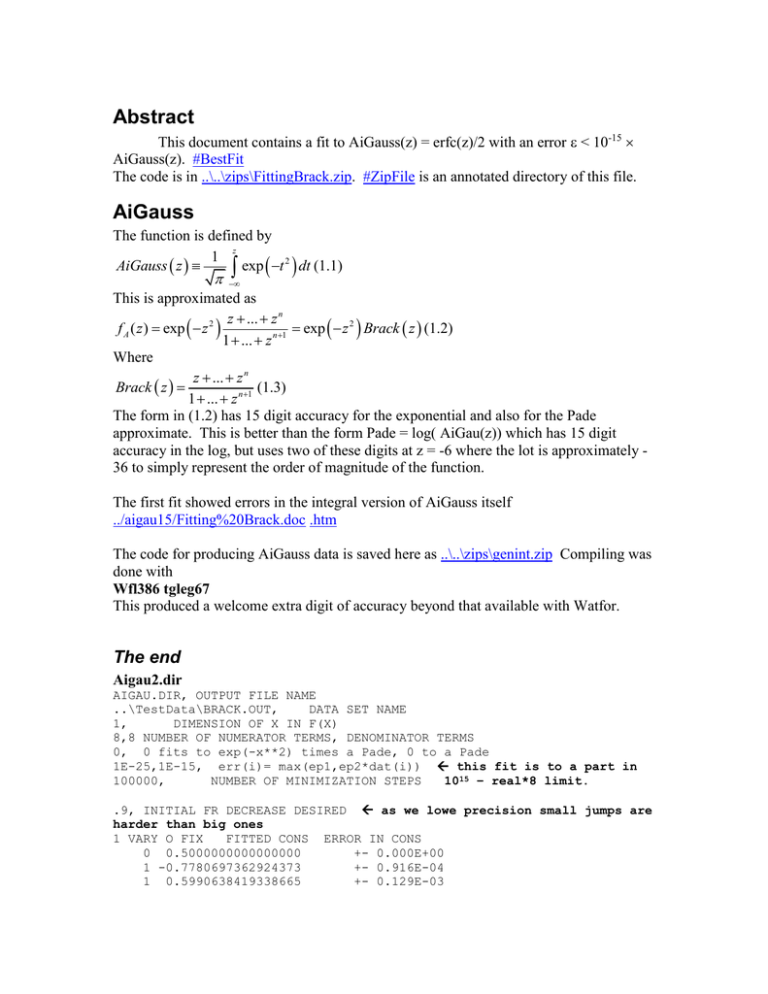
Abstract This document contains a fit to AiGauss(z) = erfc(z)/2 with an error < 10-15 AiGauss(z). #BestFit The code is in ..\..\zips\FittingBrack.zip. #ZipFile is an annotated directory of this file. AiGauss The function is defined by z 1 2 AiGauss z exp t dt (1.1) This is approximated as z ... z n f A ( z ) exp z 2 exp z 2 Brack z (1.2) 1 ... z n 1 Where z ... z n (1.3) Brack z 1 ... z n 1 The form in (1.2) has 15 digit accuracy for the exponential and also for the Pade approximate. This is better than the form Pade = log( AiGau(z)) which has 15 digit accuracy in the log, but uses two of these digits at z = -6 where the lot is approximately 36 to simply represent the order of magnitude of the function. The first fit showed errors in the integral version of AiGauss itself ../aigau15/Fitting%20Brack.doc .htm The code for producing AiGauss data is saved here as ..\..\zips\genint.zip Compiling was done with Wfl386 tgleg67 This produced a welcome extra digit of accuracy beyond that available with Watfor. The end Aigau2.dir AIGAU.DIR, OUTPUT FILE NAME ..\TestData\BRACK.OUT, DATA SET NAME 1, DIMENSION OF X IN F(X) 8,8 NUMBER OF NUMERATOR TERMS, DENOMINATOR TERMS 0, 0 fits to exp(-x**2) times a Pade, 0 to a Pade 1E-25,1E-15, err(i)= max(ep1,ep2*dat(i)) this fit is to a part in 100000, NUMBER OF MINIMIZATION STEPS 1015 – real*8 limit. .9, INITIAL FR DECREASE DESIRED as we lowe precision small jumps are harder than big ones 1 VARY O FIX FITTED CONS ERROR IN CONS 0 0.5000000000000000 +- 0.000E+00 1 -0.7780697362924373 +- 0.916E-04 1 0.5990638419338665 +- 0.129E-03 1 -0.2771270371606460 1 0.8027282341142808E-01 1 -0.1379770398066123E-01 1 0.1113061469828807E-02 1 0 1 -2.684518639716602 1 3.227282589432518 1 -2.263586666841055 1 1.006883612355409 1 -0.2865296587487073 1 0.4891172945745505E-01 1 -0.3945696943660320E-02 1 0 CHIS=0.3550E+08 FOR 5001 DATA CHI USED IN CALCULATING ERRORS ++++- 0.891E-04 0.354E-04 0.805E-05 0.857E-06 +++++++- 0.183E-03 0.465E-03 0.520E-03 0.330E-03 0.127E-03 0.285E-04 0.304E-05 POINTS IS 0.3550E+08 Figure 1 fi-fA(xi) In this case fi is exp(z2) AiGauss(z), and fA(x) = Brack(x) with the 8 numerator and denominator constants shown above. The quantitiy minimized emphasizes the left side of figure 1. The numerical thickness in the data to the left indicates how far the fit has to go to get to the noise level. I:\PUBLIC~1\nlfit\EXPTIM~1>mpnlfit aigau2.dir the complete output is below, but this is NADIR=aigau2.dir a good time for coffee. NAOUT=AIGAU.DIR NADAT=..\TestData\BRACK.OUT ND= 1 VORF CONS 0 0.500000 1 -0.778070 1 0.599064 1 -0.277127 1 0.802728E-01 1 -0.137977E-01 1 0.111306E-02 1 0.000000E+00 1 -2.68452 1 3.22728 1 -2.26359 1 1.00688 1 -0.286530 1 0.489117E-01 1 -0.394570E-02 1 0.000000E+00 FIT IS BEING MADE TO DATA IN FILE ..\TestData\BRACK.OUT FR,CHI,CHB,CHL 0.900000000 35499382.3 0.100000000E+67 0.500000000E+67 FR,CHI,CHB,CHL 0.729000000 25968696.2 25879049.7 35499382.3 FR,CHI,CHB,CHL 0.387420489 10184521.6 10060805.0 25968696.2 FR,CHI,CHB,CHL 0.581497370E-01 556637.656 592227.255 10184521.6 from bnraph going low cannot get to .01 * chi with any lambda exp(-175) FR,CHI,CHB,CHL 0.100000000E-01 16867.8334 6673.35984 556637.656 from bnraph going low FR,CHI,CHB,CHL 0.100000000E-01 9421.78133 9466.63002 16867.8334 from bnraph going low FR,CHI,CHB,CHL 0.100000000E-01 9411.07375 9407.58683 9421.78133 from bnraph going low FR,CHI,CHB,CHL 0.109000000 9423.80202 9409.60583 9411.07375 IREV= 1 IEND=99993 from bnraph going low FR,CHI,CHB,CHL 0.910900000 9423.80202 9409.60583 9411.07375 IREV= 2 IEND=99993 from bnraph going low FR,CHI,CHB,CHL 0.991090000 9423.80202 9409.60583 9411.07375 IREV= 20 IEND=99993 I modified the code, so that if it keeps getting the same value it jumps to the last IREV – within 20-100, the chi-square at this level is dominated by truncation errors. AT END FR, CHI 0.999109000 9411.07375 TEMP2= 0.000000000E+00 NEW SECTION FR= 0.9991090000000000 nlfit is set to automatically restart FR,CHI,CHB,CHL 0.999999990 9411.07375 0.100000000E+67 0.500000000E+67 FR,CHI,CHB,CHL 0.999999970 9411.07375 9411.07347 9411.07375 IREV= 1 IEND=99992 FR,CHI,CHB,CHL 0.999999997 9411.07375 9411.07372 9411.07375 IREV= 2 IEND=99992 FR,CHI,CHB,CHL 0.999999999 9411.07375 9411.07374 9411.07375 AT END FR, CHI 0.999999999 9411.07375 TEMP2= 0.999999901E-09 NEW SECTION FR= 0.9999999990000000 CHI AT END OF FIT 9411.0737524199120000 0 0.5000000000000000 +0.0000000000000000 1 -0.8591435477130216 +- 1.6272308649864600D-004 1 0.7341466366171062 +- 2.5735696428003250D-004 1 -0.3871217792735996 +- 2.0090444822930290D-004 1 0.1342351250044111 +- 9.4349896125745370D-005 1 -0.0304744298576865 +- 2.7806336792956480D-005 1 0.0042054633161981 +- 4.8818201328104450D-006 1 -2.7497424824452200D-004 +- 4.0523682417858010D-007 1 -2.8466662625211940 +- 3.2544617298786200D-004 1 3.6804121795519390 +0.0008819329591858 1 -2.8327305035912660 +0.0010715148057411 1 1.4258647627189870 +0.0007606586755338 1 -0.4833027070743471 +- 3.4312244331430270D-004 1 0.1085165756053468 +- 9.9288237674976140D-005 1 -0.0149079729638434 +- 1.7305634415493940D-005 1 0.0009747584530339 +- 1.4365264327455150D-006 FINAL CHIT= 9411.0737524199120000 CHI/DEG OF FREE 1.8874997497833760 RESULTS IN FILE AIGAU.DIR The entire run takes about ½ hour on a 1 Giga-Hertz laptop. Aigau.dir aigau2.dir, OUTPUT FILE NAME ..\TestData\BRACK.OUT, DATA SET NAME 1, DIMENSION OF X IN F(X) 8,8 NUMBER OF NUMERATOR TERMS, DENOMINATOR TERMS 0, 0 fits to exp(-x**2) times a Pade, 0 to a Pade 1E-25,1E-15, err(i)= max(ep1,ep2*dat(i)) 100000, NUMBER OF MINIMIZATION STEPS .9, INITIAL FR DECREASE DESIRED 1 VARY O FIX FITTED CONS ERROR IN CONS 0 0.5000000000000000 +- 0.000E+00 1 -0.8591435477130216 +- 0.163E-03 1 0.7341466366171062 +- 0.257E-03 1 -0.3871217792735996 +- 0.201E-03 1 0.1342351250044111 +- 0.943E-04 1 -0.3047442985768653E-01 +- 0.278E-04 1 0.4205463316198079E-02 +- 0.488E-05 1 -0.2749742482445220E-03 +- 0.405E-06 1 -2.846666262521194 +- 0.325E-03 1 3.680412179551939 +- 0.882E-03 1 -2.832730503591266 +- 0.107E-02 1 1.425864762718987 +- 0.761E-03 1 -0.4833027070743471 +- 0.343E-03 1 0.1085165756053468 +- 0.993E-04 1 -0.1490797296384342E-01 +- 0.173E-04 1 0.9747584530339248E-03 +- 0.144E-05 CHIS= 9411. FOR 5001 DATA POINTS CHI USED IN CALCULATING ERRORS IS 9411. Figure 2 (f-fA)/(1e-15*f) The region -6<z<4 is approaching its accuracy limit. This is probably caused by truncation errors in evaluating the integrals. To the extent that these effects are “random” the underlying curve is more accurate by a factor of (Nd/Ncons) = 17. Both regions have systematic errors on the order of 2 implying that this fit does not quite reach the goal. The pass with 9,9 unlike the earlier ones, does not drop chi-square by orders of magnitude. The numerical noise ~ 100 also stops a systematic approach to the minimum, once its vicinity has been reached. FIT IS BEING MADE TO DATA IN FILE ..\TestData\BRACK.OUT FR,CHI,CHB,CHL 0.900000000 9612.87997 FR,CHI,CHB,CHL 0.729000000 7079.62515 from bnraph going low FR,CHI,CHB,CHL 0.387420489 6713.67300 from bnraph going low FR,CHI,CHB,CHL 0.152334763 6711.56567 from bnraph going low FR,CHI,CHB,CHL 0.120885292 6689.95567 from bnraph going low FR,CHI,CHB,CHL 0.100000000E-01 6677.24298 from bnraph going low FR,CHI,CHB,CHL 0.100000000E-01 6639.01696 from bnraph going low FR,CHI,CHB,CHL 0.100000000E-01 6694.62463 IREV= 1 IEND=99993 from bnraph going low FR,CHI,CHB,CHL 0.901000000 6694.62463 IREV= 2 IEND=99993 from bnraph going low FR,CHI,CHB,CHL 0.990100000 6694.62463 0.100000000E+67 0.500000000E+67 7007.78950 9612.87997 6599.35985 7079.62515 6691.10203 6713.67300 6705.41629 6711.56567 6685.54279 6689.95567 6674.19657 6677.24298 6635.20438 6639.01696 6635.20438 6639.01696 6635.20438 6639.01696 IREV= 20 IEND=99993 FR,CHI,CHB,CHL 0.999010000 6639.01696 6639.01696 6639.01696 AT END FR, CHI 0.999010000 6639.01696 TEMP2= 0.000000000E+00 NEW SECTION FR= 0.9990100000000001 FR,CHI,CHB,CHL 0.999999990 6639.01696 0.100000000E+67 0.500000000E+67 FR,CHI,CHB,CHL 0.999999970 6639.01696 6639.01676 6639.01696 At this IREV= 1 IEND=99992 level there are no small predictions – rather than FR,CHI,CHB,CHL 0.999999997 6639.01696 6639.01694 6639.01696 the IREV= 2 IEND=99992 traditional fr 1, would do better with fr .9 so FR,CHI,CHB,CHL 0.999999999 6639.01696 6639.01695 6639.01696 that a larger AT END FR, CHI 0.999999999 6639.01696 distance in parameter space is TEMP2= 0.999999953E-09 attempted. NEW SECTION FR= 0.9999999990000000 Figure 3 (fi-fA(xi))/(fi 1e-15) The systematic errors appear to be on the order of 5 10-16. The “random” errors result in function errors that are reduced from the fluctuationa above by a factor approximately equal to 5000/18 = 16 so that these are also less than 1 10-15. Following is last constant file with all updates aigau.dir, OUTPUT FILE NAME ..\TestData\brack.OUT, DATA SET NAME 1, DIMENSION OF X IN F(X) 9,9 NUMBER OF NUMERATOR TERMS, DENOMINATOR TERMS 0, 0 fits to exp(-x**2) times a Pade, 0 to a Pade 1E-30,1E-15, err(i)= max(ep1,ep2*dat(i)) 100000, NUMBER OF MINIMIZATION STEPS .9, INITIAL FR DECREASE DESIRED 1 VARY O FIX FITTED CONS ERROR IN CONS 0 0.5000000000000000 +- 0.000E+00 1 -1.065781843119121 1 1.098849939447941 1 -0.7059835832256011 1 0.3064328550407249 1 -0.9175866513292681E-01 1 0.1853701251033871E-01 1 -0.2323566331513835E-02 1 0.1400748062111785E-03 1 -3.259942853333778 1 4.876151480518089 1 -4.406424837428250 1 2.661133284964304 1 -1.118888036108821 1 0.3293940293195529 1 -0.6596029956005756E-01 1 0.8236827162542478E-02 1 -0.4965522790119376E-03 CHIS= 6368. FOR 5001 DATA CHI USED IN CALCULATING ERRORS +- 0.254E-01 +- 0.441E-01 +- 0.380E-01 +- 0.202E-01 +- 0.709E-02 +- 0.163E-02 +- 0.228E-03 +- 0.152E-04 +- 0.507E-01 +- 0.145 +- 0.189 +- 0.147 +- 0.746E-01 +- 0.256E-01 +- 0.581E-02 +- 0.810E-03 +- 0.540E-04 POINTS IS 6368. These constants above give 7 AiGauss( z ) exp z 2 c z I 0 8 I 1 I 1 cI 7 z I 1015 I 1 Note that the signs of the constants are such that for negative z, every term adds. There is no cancellation and the truncation error is minimized. There is a slight gain in fitting the results of the integral directly. The constants below are slightly better. Exp(-z2)Brack(z) The code was designed to fit AiGauss directly. Starting with the constants above, a number of formats needed changing in ..\TestData\genint\TGLEG67.FOR to get the full range of the data – The data above with much smaller derivatives seems unaffected by these changes. The final fit begins with the constants from fitting brack above and a chisquare of 4647. This is lower than that for brack. The values used now are direct integration values while brack’s fit multiplied these values by exp(z2). It appears that this introduces an extra 2000 into the chi-square. aigau2.dir, OUTPUT FILE NAME ..\TestData\aigauss.OUT, DATA SET NAME 1, DIMENSION OF X IN F(X) 9,9 NUMBER OF NUMERATOR TERMS, DENOMINATOR TERMS 1, 1 fits to exp(-x**2) times a Pade, 0 to a Pade 1E-30,1E-15, err(i)= max(ep1,ep2*dat(i)) 100000, NUMBER OF MINIMIZATION STEPS .9, INITIAL FR DECREASE DESIRED 1 VARY O FIX FITTED CONS ERROR IN CONS 0 0.5000000000000000 +- 0.000E+00 1 -1.502885941371286 +- 0.652E-01 1 1.851590712127221 +- 0.113 1 -1.350498684163228 +- 0.964E-01 1 0.6470300251477153 +- 0.510E-01 1 -0.2101536907945629 +- 0.178E-01 1 0.4549469611716167E-01 1 -0.6057434494797435E-02 1 0.3854291140973252E-03 1 -4.134151049838160 1 7.368071342513580 1 -7.633077301200458 1 5.148920726637210 1 -2.373642689043555 1 0.7557095175197603 1 -0.1619578118794217 1 0.2147303973187547E-01 1 -0.1366310760644399E-02 CHIS= 4580. FOR 5001 DATA CHI USED IN CALCULATING ERRORS +- 0.405E-02 +- 0.562E-03 +- 0.371E-04 +- 0.130 +- 0.372 +- 0.482 +- 0.372 +- 0.188 +- 0.640E-01 +- 0.144E-01 +- 0.199E-02 +- 0.131E-03 POINTS IS 4984. The minimum without the truncation correction was 4519. Simply re-reading the constants goes to 4619 4566 (This is the random/truncation zone). The constants above are the best for representing AiGauss. Figure 4 Final fit to AiGauss. -- Black is data, blue is fit, red is |data-fit| Figure 5 (data-fit)/(data 10-15) There is a truncation like error possibly in the Gauss Quadrature for -5.5<z<-3.5. There is a small systematic effect at about -2.0 of a size < 1. In general the “random” error in the fit is less than that in the data by a factor of (5000/18) = 16.7 that the error is < 10-15. The values below -6 are quickly generated to this accuracy using the asymptotic expansion ..\..\TestData\genint\Expanding the integrand.htm. doc. -..\..\TestData\genint\genint.zip Those above 0 are 1-the value below zero. Thus the code to find AiGauss everywhere is ready to write. Using the files The code for making this fit is in ..\..\zips\FittingBrack.zip Directory of FittingBrack.zip aigau2.dir -- sample direction file for fitting brack.out AIGAUSS.OUT -- data of the form exp(-z2)*Brack(z) generated by direct integration of Gaussian BRACK.OUT -- data of the form Brack(z) Integral has been multiplied by exp(z2) with slight loss of accuracy transmp.exe -- Bailey’s code for converting to multi-precision -..\..\..\..\MultiplePrecision\bailey\Welcome.htm mpfun.for --- Bailey’s set of multi-precision routines nlfit.wpj Watcom ide’s for making nlfit nlfit.tgt cnlfit.bat -- bat file for using wfl386 to make nlfit mpnlfit.wpj Watcom ide’s for making mpnlfit mpnlfit.tgt cmpnlfit.bat – bat file for using wfl386 to make mpnlfit Fortran files MAOPEN.FOR -- used by Watfor MSOPEN.FOR – used by watcom WSYSTEM.FOR -- used by Watfor openwsys.for – used by watcom nlfpade.for - nlfit slightly modified to have Nnum, Nden, eps1, and eps2. Passes flag for fitting Brack or exp*Brack to poly MPnlfpade.for – Generated from nlfpade by running transmp.exe ROBMIN.FOR --- minimization code. Run transmp.exe and enter robmin.for to produce MProbmin.for --- MProbmin polyexpa.for --- The poly routine for making exp(x2)Brack(x) or simply Brack(x)
